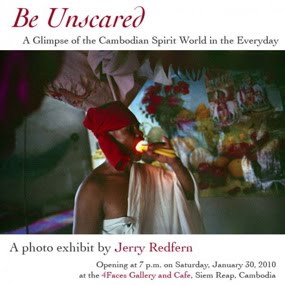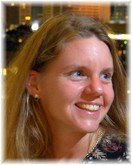The spirit world
 If you are in Siem Reap this weekend, catch the opening of the new Jerry Redfern photo exhibition at 4Faces Gallery, a block away from Pub Street. It begins at 7pm on Saturday 30th, just a pity I won't be there. Here's what Jerry has to say about his Be Unscared: A Glimpse of the Cambodian Spirit World in the Everyday exhibition.
If you are in Siem Reap this weekend, catch the opening of the new Jerry Redfern photo exhibition at 4Faces Gallery, a block away from Pub Street. It begins at 7pm on Saturday 30th, just a pity I won't be there. Here's what Jerry has to say about his Be Unscared: A Glimpse of the Cambodian Spirit World in the Everyday exhibition.This project is a first glimpse into the Cambodian spirit world – as it can be no more than that for an outsider. I have been a photojournalist for years and have worked in Cambodia regularly since 1998. I like to think this gives me a fairly good insight into daily life here. But I also understand that I will never be able to view the Cambodian cosmos as the Khmer do.
That cosmos is a blend of ancient Hinduism (as seen at the temples of Angkor); spirit worship that comes in part from the people who for centuries have hacked lives from capricious jungles; and Buddhism, with its prayers, chants, scriptures, arcane writing and its stories of religious men reborn into worlds beyond this one. We as foreigners know this spirit world exists in Cambodia, but we often miss the common gestures – a twist of the head, a bit of graffiti, a monk's breath, the flames of a candle.
The title “Be Unscared” comes from a sign at the Temple of the Floating Tree outside Phnom Penh, home to a monk with an elephant tusk that people believe can cure mental illness. And while the sign echoes one of the teachings of the Buddha, it also sums up what Cambodians have been hoping for centuries. It's a call for calm in the face of a dangerous world, whether the danger comes from the beasts of the jungle or those in Phnom Penh. On a technical note, the project is done on 35mm color negative film (which itself has become an arcane medium). The film is past-dated, which made it cheap (important for photographers these days) but that also led to a couple of unintended consequences. There are random color shifts in the old film, which are apparent in the inconsistent color of the prints. The old film also left some photos un-useably under-exposed. And then I had to get re-acquainted with taking photos and not being able to see them immediately on the back of the camera. I had to be unscared and trust that I had the images I thought I had seen. Sometimes I did – sometimes I didn't. And sometimes I had better. This exhibit is really just the start of a project I intend to work on for the foreseeable future. In most of these encounters with the Cambodian spirit world, people tell me about other sites, other people, other magic. I really don't imagine I will see all of the Khmer spirit world any time soon.
A new website is up and running for the documentary, Brother Number One, which documents the murder of New Zealand yatchsman Kerry Hamill by the Khmer Rouge in 1978. It follows his brother Rob, an Olympic champion rower, as he retraces his brother's steps and speaks to eyewitnesses and survivors. They are two thirds through filming including Rob's testimony at the ECCC last August and will return to Cambodia for the verdict in the Comrade Duch trial, expected sometime next month. Visit the website here.
Labels: 4Faces, Brother Number One, Jerry Redfern, Rob Hamill


